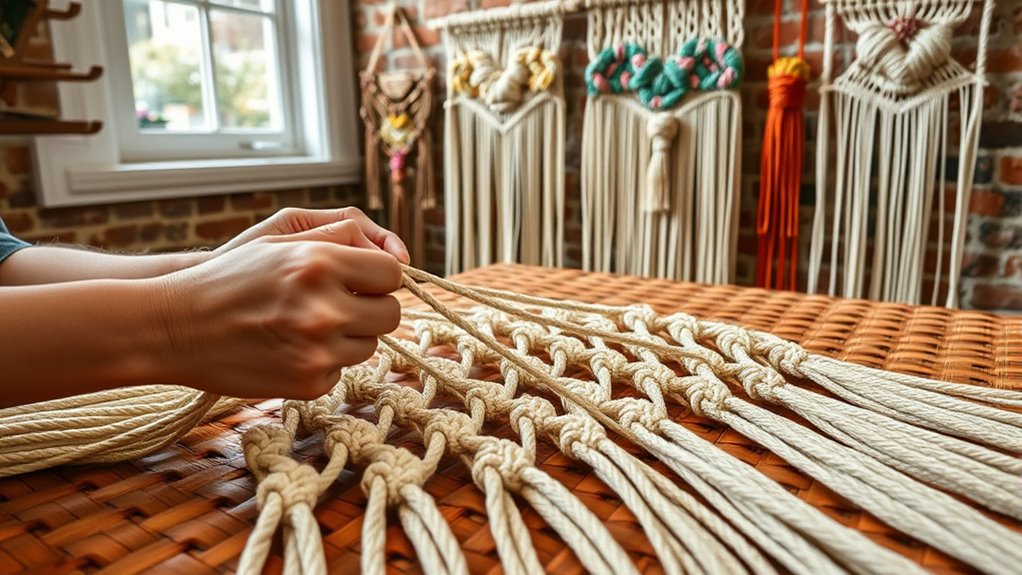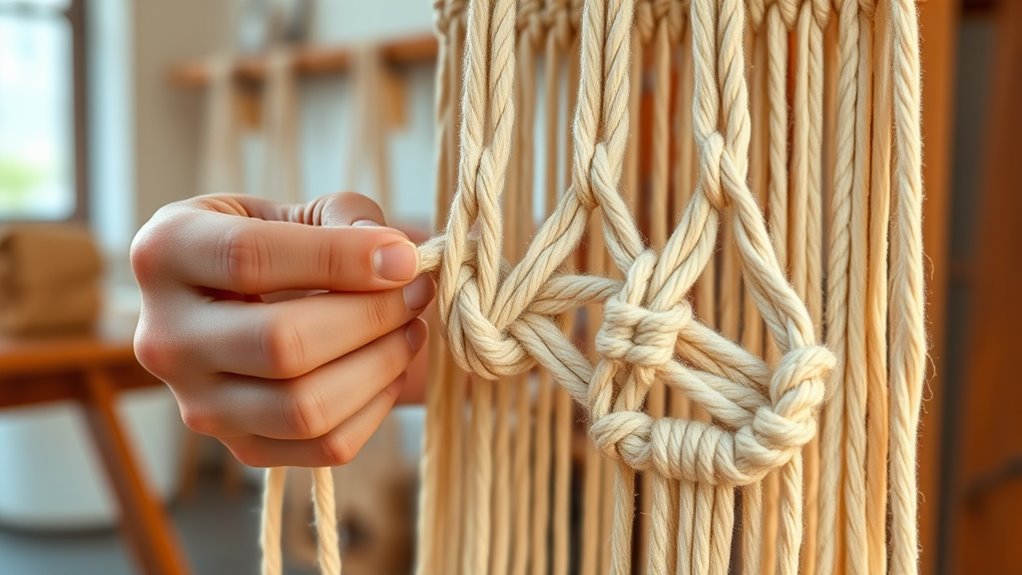In a macramé masterclass, mastering fundamental knots like square and half hitch knots is your first step. Then, focus on designing patterns by thoughtfully arranging knots, paying attention to tension, spacing, and layout. Choosing harmonious colors and placement enhances your piece’s visual impact. With patience and practice, you’ll develop your skills and create intricate designs. Keep exploring these techniques, and you’ll discover how to turn simple cords into stunning art.
Key Takeaways
- Master basic knots like square knots and half hitches to build complex macramé patterns.
- Plan and sketch your design to ensure proper knot placement and visual harmony.
- Maintain consistent tension and precise spacing for a professional, balanced look.
- Experiment with color choices and cord placement to enhance pattern impact.
- Practice regularly to develop skills, fostering creativity and intricate craftsmanship.

If you’ve ever admired the intricate beauty of macramé, now’s the perfect time to learn this timeless craft. You can transform simple cords into stunning wall hangings, plant hangers, or jewelry by mastering fundamental knot techniques. Your journey begins with understanding how each knot contributes to the overall pattern design. Every knot you learn adds to your toolkit, allowing you to create complex textures and breathtaking designs. The key is to start with the basics—square knots, half hitch knots, and lark’s head knots. Practice these until they become second nature, then experiment with combining them in different ways. As you gain confidence, you’ll discover that the possibilities for pattern design are virtually limitless.
Master basic knots to unlock limitless creative macramé patterns and designs.
When working on knot techniques, pay attention to tension and spacing. Consistent tension guarantees your work stays even, while precise spacing helps create a balanced and professional-looking piece. You’ll find that adjusting your tension slightly can dramatically change the look and feel of your project. Pattern design is about more than just following a template; it’s about understanding how each knot contributes to the overall aesthetic. Think of it as a puzzle—each piece, or knot, fits into a larger picture. As you experiment with different arrangements, you’ll start to see how small changes can create entirely new visual effects. Whether you’re aiming for a symmetrical pattern or a more freeform, organic style, knowing how to plan your pattern is indispensable.
Additionally, understanding the importance of color accuracy can help you select cords and dyes that enhance your design’s visual impact. Placement also plays a vital role in your success. Consider the layout of your cords and how each knot impacts the flow of the design. You want your knots to be placed thoughtfully so that your piece maintains its structure and visual harmony. For larger projects, sketching out your pattern beforehand can help you visualize the final product, ensuring that your pattern design and knot placements align perfectly. Remember, patience is key. Take your time to measure, plan, and execute each knot carefully. As you develop your skills, you’ll notice your projects evolve from simple cords into intricate works of art, each with its own unique pattern and personality.
Ultimately, mastering knot techniques and pattern design empowers you to create personalized, beautiful pieces. Every project becomes an expression of your creativity, and with practice, you’ll develop an intuitive sense for placement and pattern flow. Keep experimenting, learning new knots, and refining your pattern design skills. Before long, you’ll be crafting stunning macramé pieces that showcase your skill and artistic vision, making each creation a true reflection of your craftsmanship.
Frequently Asked Questions
What Types of Cords Are Best for Beginner Macramé Projects?
For beginner macramé projects, cotton cords are your best choice because they’re soft, easy to knot, and come in various thicknesses. Jute twine also works well if you prefer a rustic look and want sturdier cords. Both options are affordable, widely available, and beginner-friendly, making your first projects more enjoyable. Start with 3-5mm thickness cords to practice knots comfortably and create beautiful, durable pieces.
How Do I Correct Mistakes in My Macramé Knotting?
Imagine your project as a flowing river, and mistakes as small rocks causing ripples. To correct mistakes, gently undo the problematic knot, using your fingers or a crochet hook for knot troubleshooting. Carefully re-tie it, ensuring the tension matches surrounding knots. Don’t stress—mistake correction is part of learning. With patience, your macramé will smooth out, and each correction brings you closer to mastering beautiful, flawless knots.
Can I Incorporate Different Materials Into My Macramé Designs?
Yes, you can incorporate alternative materials into your macramé designs. Experiment with beads, feathers, or fabric strips to add texture and visual interest. Using mixed media techniques, you blend different materials seamlessly, creating unique pieces. Just guarantee your chosen materials are flexible enough for knotting and compatible with your cord. This approach allows you to personalize your creations and explore new artistic possibilities.
What Tools Are Essential for Advanced Macramé Patterns?
Ever wondered what tools elevate your macramé to advanced levels? You’ll need precision tools like sharp scissors, ratchet clamps, and a measuring tape to master advanced techniques. These tools help you achieve intricate knot patterns and precise placement, ensuring clean, professional results. Do you have the right equipment to push your skills further? Investing in quality tools makes all the difference in creating detailed, complex designs with confidence.
How Do I Securely Finish and Hang My Macramé Piece?
To securely finish and hang your macramé piece, use finishing techniques like wrapping the ends with cord or adding a decorative knot. Attach a sturdy hanging solution, such as a metal or wooden dowel, or a strong wall hook, ensuring it’s anchored properly. Double-check your knots and secure any loose ends. This way, your artwork stays safe and looks polished when displayed.
Conclusion
Now that you’ve mastered the art of macramé, your creativity knows no bounds. With every knot, pattern, and placement, you’re opening a world of endless possibilities—your skills are truly a force to be reckoned with. Keep practicing, experimenting, and pushing your limits. Before you know it, you’ll be creating stunning masterpieces that could easily outshine even the most famous textile artists. Your newfound expertise is the key to transforming simple cords into breathtaking works of art!










